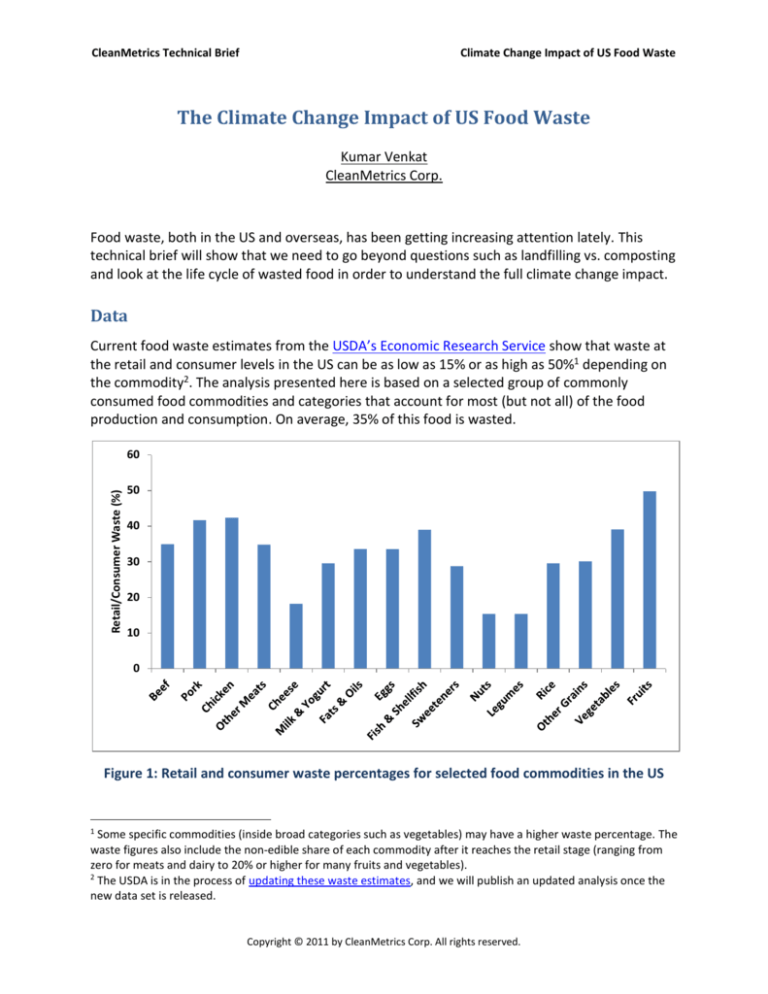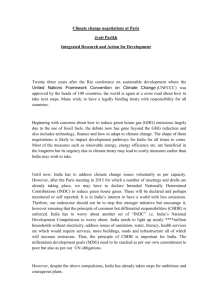
CleanMetrics Technical Brief
Climate Change Impact of US Food Waste
The Climate Change Impact of US Food Waste
Kumar Venkat
CleanMetrics Corp.
Food waste, both in the US and overseas, has been getting increasing attention lately. This
technical brief will show that we need to go beyond questions such as landfilling vs. composting
and look at the life cycle of wasted food in order to understand the full climate change impact.
Data
Current food waste estimates from the USDA’s Economic Research Service show that waste at
the retail and consumer levels in the US can be as low as 15% or as high as 50%1 depending on
the commodity2. The analysis presented here is based on a selected group of commonly
consumed food commodities and categories that account for most (but not all) of the food
production and consumption. On average, 35% of this food is wasted.
Retail/Consumer Waste (%)
60
50
40
30
20
10
0
Figure 1: Retail and consumer waste percentages for selected food commodities in the US
1
Some specific commodities (inside broad categories such as vegetables) may have a higher waste percentage. The
waste figures also include the non-edible share of each commodity after it reaches the retail stage (ranging from
zero for meats and dairy to 20% or higher for many fruits and vegetables).
2
The USDA is in the process of updating these waste estimates, and we will publish an updated analysis once the
new data set is released.
Copyright © 2011 by CleanMetrics Corp. All rights reserved.
CleanMetrics Technical Brief
Climate Change Impact of US Food Waste
Figure 1 is based on USDA data and shows that a high proportion of perishable foods end up as
waste. Much of the food waste goes to landfills.
Figure 2 shows the same data in terms of actual quantities wasted each year (million metric
tonnes per year). This combines waste percentages with quantities of the commodities
delivered to the retail stage, and scales USDA’s per-capita waste estimates to the 2008 US
population. This annual food waste estimate, for the commodities and categories considered
here, adds up to just over 62 million metric tonnes3.
Retail/Consumer Waste (MMT/year)
16
14
12
10
8
6
4
2
0
Figure 2: Retail and consumer waste quantities for selected food commodities in the US
Methodology
We used FoodCarbonScopeTM to analyze the life-cycle greenhouse gas (GHG) emissions from
producing, transporting and landfilling the wasted food (ignoring any waste prior to the retail
stage). The life cycle assessment (LCA) includes factory processing of food (such as meat
processing, canning, freezing, etc.), but excludes the impacts of food packaging and home or
restaurant cooking. We used North American life cycle inventory (LCI) data for agricultural
production and food processing from CarbonScopeDataTM (from within FoodCarbonScope) to
estimate the production emissions. We assumed a typical 1500 miles of road transport from
production to retail for all commodities (with refrigeration in transit as needed), and landfilling
3
Note that this food waste quantity is based strictly on USDA data and does not correlate with EPA estimates of
food waste in municipal solid waste.
Copyright © 2011 by CleanMetrics Corp. All rights reserved.
CleanMetrics Technical Brief
Climate Change Impact of US Food Waste
of waste in a temperate climate zone per EPA data on how methane is managed (US average of
21% methane flaring and 23.25% methane capture).
Results
Our analysis shows that 152 MMT CO2e (million metric tonnes of carbon-dioxide equivalents)
are added to the atmosphere annually from the production, transportation and disposal of the
uneaten food. If we were to include the many other food commodities that are produced and
wasted in smaller quantities, and other emission sources such as the packaging and cooking of
food destined for landfills, the overall climate change impact of food waste would likely be
higher than this estimate.
According to the Product Policy Institute, the total emissions from the provision of food in the
US are 906 MMT CO2e (imported food accounts for just over 1%). Their figure was derived
using a different methodology, but if we were to use that as a reasonable baseline, then our
estimated emissions from food waste appear to be over 16% of the national food-related
emissions. Emissions from food waste also appear to be about 2% (and likely higher) of the
total US GHG emissions. This is consistent with the recent report that food waste accounts for
3% of UK’s domestic GHG emissions.
Comparing the relative contributions of life cycle stages (Figure 3), nearly 80% of the GHG
emissions from food waste are due to production and processing. Waste disposal in a landfill
accounts for less than 15% of the emissions.
GHG Emissions (MMT CO2e/year)
140
120
100
80
60
40
20
0
Production
Transport
Waste Disposal
Figure 3: Greenhouse (GHG) emissions from wasted food: Comparing life cycle stages
Figure 4 profiles the emissions contributions of the selected commodities and categories. Even
though fruits, vegetables, grains and sweeteners are wasted in large quantities (see Figure 2),
the total GHG emissions from waste are heavily influenced by some of the meat products – in
Copyright © 2011 by CleanMetrics Corp. All rights reserved.
CleanMetrics Technical Brief
Climate Change Impact of US Food Waste
particular, beef is the dominant contributor to these emissions because of its high production
emissions footprint.
50
GHG Emissions (MMT CO2e/year)
45
40
35
Waste Disposal
30
Transport
25
Production
20
15
10
5
0
Figure 4: Greenhouse (GHG) emissions from wasted food: Comparing commodities
Conclusion
This preliminary analysis highlights the significant climate change impact of wasted food in the
US, and the need to analyze it from a lifecycle perspective. Most of the GHG emissions from
wasted food are attributable to agricultural production. There are clearly opportunities to both
reduce emissions and reallocate some of the wasted agricultural production capacity to other
uses such as growing feedstocks for next-generation biofuels. Moreover, a portion of the
emissions reduction could be given up in return for using the surplus food to reduce hunger and
malnutrition. We should begin to think of GHG emissions as a form of currency. We can use
them for productive purposes, such as providing sufficient food and fuel for everyone, but
emissions that do not serve a useful purpose are expenses that should be targeted for
reduction.
Copyright © 2011 by CleanMetrics Corp. All rights reserved.








